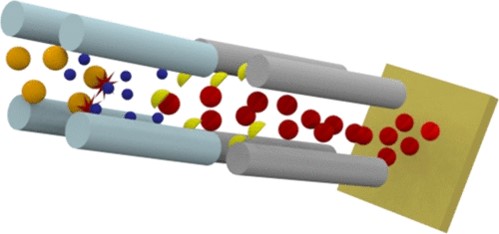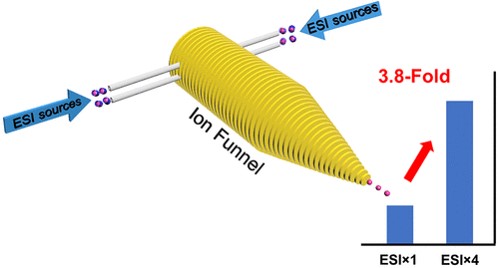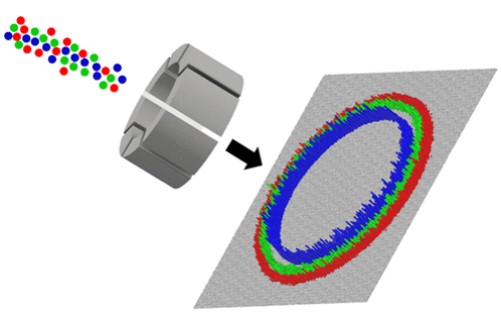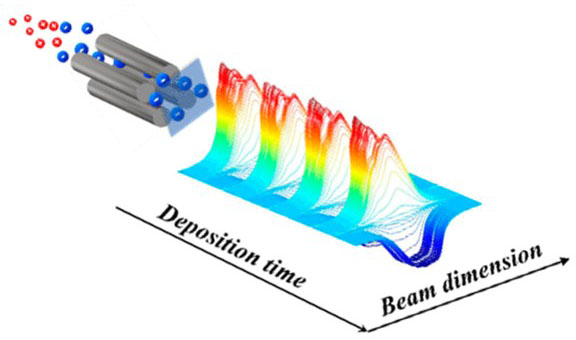Instrument Development
Development of Instrumentation for Soft Landing of Fragment Ions

Fragment polyatomic ions are unique and largely unexplored building blocks for the design of new materials and interfaces. These species cannot be generated using conventional condensed-phase chemistry. We have developed an ESI-based instrument that generates high and stable currents of mass-selected fragment ions in the gas phase for deposition onto surfaces.
Publications
Samayoa-Oviedo, H. Y., Behrend, K.-A., Kawa, S., Knorke, H., Su, P., Belov, M. E., Anderson, G., Warneke, J., and Laskin, J.. (2021) Design and Performance of a Soft-Landing Instrument for Fragment Ion Deposition. Analytical Chemistry 93, 14489 14496. https://doi.org/10.1021/acs.analchem.1c03009
Multiplexing of Electrospray Ionization Sources Using Orthogonal Injection into an Electrodynamic Ion Funnel

We have developed a high-flux multiplexed electrospray ionization (ESI) ion source for applications in analytical and preparative mass spectrometry. This is achieved using up to four orthogonal injection inlets implemented on the opposite sides of an electrodynamic ion funnel interface. The signal increases in proportion with the number of inlets. The performance of the new multiplexing approach was examined using different classes of analytes covering a broad range of mass and ionic charge.
Collaborative study with Larriba-Andaluz group at IUPUI
Publications
Su, P.,Chen, X.; Smith, A. J., Espenship, M. F., Oviedo, H. Y. S., Wilson, S. M., Gholipour-ranjbar, H., Larriba-andaluz, C., Laskin, J. Multiplexing of Electrospray Ionization Sources Using Orthogonal Injection into an Electrodynamic Ion Funnel. Anal. Chem., 2021, 93, 11576–11584.
Using a Rotating Wall Mass Analyzer to Measure High Mass Species

A designed rotating wall mass analyzer (RWMA) is used to provide a uniform rotating electric field that acts as a mass dispersive device. The deflected ions draw ring-like patterns onto a surface where the size of the ring is inversely related to the mass of the ion. The mass range can be explored simply by changing the frequency of the rotating electric field. This offers potential for high throughput deposition for surface preparative techniques, but also demonstrates the ability to analyze high mass species, such as charged nanodroplets. Measuring these droplets from different solvent compositions can give insights into electrospray ionization processes and how this might reduce chemical noise observed in mass spectrometry.
Publications
- Su, P., Espenship, M. F. , Laskin, J. Principles of Operation of a Rotating Wall Mass Analyzer for Preparative Mass Spectrometry. Journal of the American Society for Mass Spectrometry 2020, 31 (9), 1875-1884 DOI: 10.1021/jasms.0c00140 https://pubs.acs.org/doi/pdf/10.1021/jasms.0c00140
- P. Su, H. Hu, D. Unsihuay, D. Zhang, T. Dainese, R. E. Diaz, D. K. Gunaratne, H. Wang, F. Maran, J. Laskin “Preparative Mass Spectrometry Using a Rotating Wall Mass Analyzer”, Angew. Chem., 59, 7711-7716 (2020). DOI: 10.1002/ange.202000065 https://onlinelibrary.wiley.com/doi/pdf/10.1002/anie.202000065
Design and Performance of a Dual-Polarity Instrument for Ion Soft Landing

We have developed a high-flux dual-polarity ion soft landing instrument for the deposition of mass-selected ions on surfaces. This instrument enables the controlled preparation of ionic layers using co-deposition of mass-selected anions and cations onto surfaces with a varying extent of charge imbalance. Both layer-by-layer (LBL) and co-deposition using fast polarity switching modes that cannot be achieved using other deposition techniques.
Publications
- Su, H. Hu, J. Warneke, M. E. Belov, G. A. Anderson, J. Laskin “Design and Performance of a Dual-Polarity Instrument for Ion Soft Landing”, Anal. Chem., 91, 5904-5912 (2019). DOI: 10.1021/acs.analchem.9b00309 https://pubs.acs.org/doi/10.1021/acs.analchem.9b00309